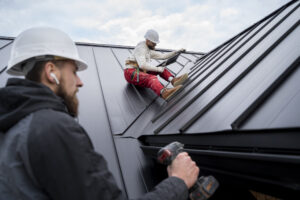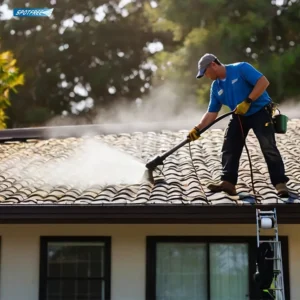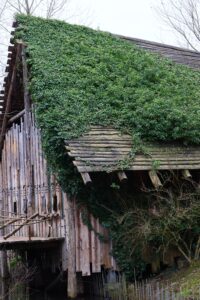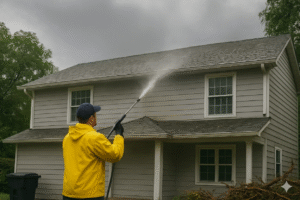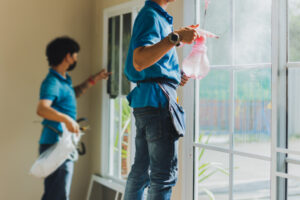When the Atlantic changes its mood, Florida is the first to feel it. As a result, from June to November, Hurricane season is basically a long string of really bad weather days. That’s why Florida Exterior Cleaning Services is not really a matter of just making the house look good from the street—they are a part of the core of the hurricane prep for homes that shields the roof, the walls, the drainage, and the people inside.
Before we jump into it, here are a few context points:
- The modern 1991-2020 climate normal counts annually approximately 14 named storms, 7 hurricanes, and 3 major (Category 3+) hurricanes in the Atlantic. Florida can be affected by the wind, the storm surge, and the rain, even if the system does not make a direct landfall in the state.
- Most of the problems related to flooding around the houses originate from the situation when the drainage is overwhelmed (for example, gutters, downspouts, and yard inlets clogged with leaves and dirt) and water entering the house due to strong wind (for example, damaged sealants, paint/caulk that has been worn by the impact of the wind and debris, and blocked weep paths).
- Salt, debris, and microbial growth (such as algae and mildew) that are inside the roofing, the paint films, the fasteners, and the window gaskets—especially the ones that are located along the coast—accelerate the process of deterioration.
In other words, a deliberate exterior cleaning-and-inspect plan will contribute to lowering the risk, extending the service life, and speeding up the post-storm recovery.
Your Hurricane Season Exterior Cleaning Checklist
1) Roof & Roofline Readiness
- Soft-wash the roof (asphalt, tile, or metal) to remove algae and salt films that trap moisture and hide early damage. Don’t use high-pressure blasting on shingles.
- Gutter & downspout cleaning: Remove leaves, twigs, and shingle granules. A 40-foot run of gutter filled with wet debris can weigh more than 100 lb—enough to pull fasteners during high winds.
- Downspout discharge: Make sure that splash blocks or extensions return water 6–10 feet away from the foundation. Check that yard grates and French drains are open.
- Fasteners & flashing: Inspect for lifted shingles/tiles, loose ridge caps, corroded screws on metal panels, open seams, and damaged chimney or solar flashings after the Roof cleaning.
- Trim branches by 8–10 feet from the roof to lessen the wear and the impact.
2) Exterior Walls, Siding & Soffits
- Use a low-pressure wash (vinyl, stucco, fiber-cement) to get rid of mildew, salt, and chalking—most of which is on the windward walls. Apply the chemical from the bottom up and rinse from the top down.
- Crack & caulk check: Once the cleaning is done, it will be easier to find hairline cracks and caulk lines that have been worn out. Put a new seal around hose bibs, light fixtures, and J-channel transitions.
- Soffit & fascia vents: Use a vacuum or gentle rinse to keep attic intake free for pressure equalization during storms.
3) Windows, Doors & Openings
- Thoroughly cleaning window tracks, weep holes, and gaskets; flushing weeps so that wind-driven rain has a way to go out.
- After cleaning the weatherstripping, inspect it—check for compression set, gaps, or brittle PVC. Change it if necessary.
- Remove and clean: shutters & impact panels. Label and stage hardware. Lubricate anchors and check the fit.
4) Driveways, Pavers & Drainage Paths
- Use the pressure washer (correct nozzles & PSI) to remove algae and sediment that cause driveways to be slippery and clog storm drains.
- After cleaning, re-sand paver joints with polymeric sand; the locked joints will be resistant to washout and weed intrusion even during heavy rain.
- Spot-grade mulch beds and swales so that water can flow away from the structures. Continue mulch depth <2–3 inches so that there will be no damming against the walls.
5) Screens, Pool Cages & Lanais
- Make sure to remove all the sunscreen residues and algae with the rinse and degrease process, as these substances weaken the mesh fibers.
- After the cleaning, do the Tension & fasteners work, which consists of tightening loose screen spline and changing rusted screws at base rails and kick plates.
6) Decks, Railings & Outdoor Kitchens
- Remove grease from surfaces that are made of stone or stainless steel to dissolve salt and acid residues through our deck cleaning services.
- After patio cleaning and drying wood, seal it; water-repellent finishes will greatly help the wood resist moisture and will not warp during a long rain period.
- Stop the gas/electric supply and put a cover on them if your area advises so when a storm is about to come.
Why Cleaning Method Matters (Safety & Materials)
- Soft Wash vs. High Pressure: Generally, roofs (asphalt/architectural shingles, coated tiles, and most metals) should be soft-washed—using a detergent that is safe for roofs and at low pressure. High PSI blasts sever the granules of the shingles, can scar the surface of the roof that is coated, and ignite the water to go under the laps, thus causing leaks.
- Surface-appropriate chemistry: Alkaline detergents are good for lifting ram growth; oxalic or citric blends are excellent for removing rust/tannin from the masonry; surfactants help by sticking to the surface and being short of runoff.
- Plant & property protection: Professional residential cleaning services pre-wet the plants with water, apart from that, downspouts are directed, and very important, steps like neutralizing runoff are taken—this is very necessary for sandy soils of Florida and also for the nature of sensitive ornamentals.
Annual Schedule (Florida Reality Check)
- Pre-season (April–May): Entire-house exterior washing, gutter and roof cleaning, window tracks, and drainage inspection.
- Mid-season (July/August): Brief rinse of roof edges, gutters, lanai/pool cage, and windward walls; clear yard drains.
- Post-season (Nov/Dec): Full sound of the outer part of the house, corrosion control of metals, paint/sealants of the place by hand, paver re-sand if necessary. Consider our fall seasonal cleaning.
Such a rhythm of work leads to a lesser number of sudden breakdowns, saving the equipment and the surface layer, and also it is good for the environment as the rainwater continues to flow naturally in the correct places—away from your home.</
DIY vs. Pro: When to Call Florida Exterior Cleaning Services
DIY is acceptable for: low-risk rinses, light walkway cleaning, window track flushing, and leaf removal.
Professionals should be hired for: work on the roof, multi-story work, chemical soft-washing, removal of oxidation, paver restoration, or complicated drainage cleaning.
Choosing a provider (quick vetting list):
- Written scope (methods, chemicals, pressures) and plant-protection plan
- Proof of insurance & worker safety practices (harnesses, ladder stabilizers)
- Knowledge of Florida Exterior Cleaning Services and materials typical of your house (tile roofs, stucco, aluminum cages)
- Before/after portfolio and transparent pricing available in our gallery
- Optional maintenance plans coordinated with the hurricane season
Post-Storm Cleaning & Recovery
After the occurrence of a hurricane, it is advisable that your first concern be safety, and then restoration. Efficient <strong>storm season maintenance</strong> is not only about getting ready; it is also about having a detailed post-storm clean-up to avert any future damage and to be certain that the structure is safe.
- Be safe: Turn off the power, do not touch any downed power lines, be careful if your roof has been damaged, and do not stand in water.
- Triage gutters and drains first: Remove the blockages so that water will not flow back into garages and entries with our emergency gutter cleaning.
- Remove salt quickly: Within 24-48 hours, rinse with fresh water the parts of the building that were facing the wind, metals, and glass to limit corrosion through our pressure washing services.
- After the first rinse, damage is going to be revealed, so take photos of the damage and send them to your insurer/contractor.
- Arrange for a soft wash to get rid of embedded organics and dirt, especially if the house has been flooded.
Smart Add-Ons That Pay Off
- Gutter guards (good metal mesh) to lessen the clogs that happen during the season.
- Landscaping that is nice to the backflow: Bark mulch vs. river rock near the eaves; rock doesn’t float and doesn’t clog the drains.
- Pool cage and lanai storm-rated screens and fasteners.
- Coastal houses use corrosion-resistant hardware (316 stainless).
Why This Matters: Performance + Peace of Mind
Cleaning is thus a form of preventative engineering. It is essentially you who is upgrading:
- Water system (dirty water is removed)
- Wind system (fewer points where the wind can damage)
- Life span of the materials (less rust, less rotting)
- Security (less slip/fall and throwing up of objects)
As Exterior cleaning is one of the factors contributing to a clean, closed, and free-flowing exterior, it is thus a quieter, safer home when the bad weather comes.
About Squeaky Clean Services (Florida)
In a situation where you do not have much time and storms are approaching, being precise is very important. Squeaky Clean Services offers Florida Exterior Cleaning Services that are a response to hurricane situations. These services include roof soft washing, gutter and roof cleaning, stucco/soffit care, paver restoration, drainage clearing, and corrosion-safe rinses for the homes located near the sea. The team not only records every task with pictures but also takes care of the landscaping and uses the correct chemistry for the surface so that your home will be ready for the storm and safe in terms of the warranty. They will create a maintenance plan that is in harmony with the season for your property, if that is what you want, instead of a template.
We serve homeowners throughout Jacksonville, Orange Park, Ponte Vedra, Mandarin, and St. John with specialized hurricane season preparation.
Contact us today to schedule your pre-season exterior cleaning or learn more about our services.
Conclusion
A clean home reflects the resilience of the family living in it and is, therefore, less likely to require reactive repairs. A proactive intervention is always better than a reactive one; that’s why by performing the hurricane season cleaning of your home as per the following checklist, you can protect your home, make it safer, and spend less after the storm.
If you want to keep your home in perfect condition in a way that is suitable for the Florida climate, you can count on Squeaky Clean Services to provide you with accurate cleaning, preparation for the storm, and the calmness that lasts throughout the whole year. Request your free estimate today.



